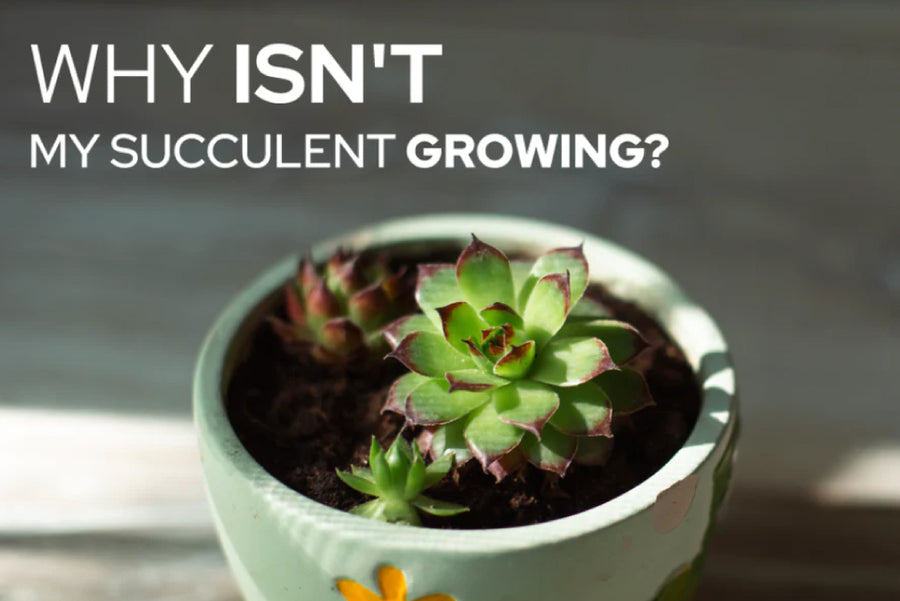Succulents are incredibly hardy and are best known as some of the easiest houseplants to raise. However, just because they’re considered “easy” doesn’t mean that succulents have specific needs for them to grow! If your indoor succulent isn’t getting any bigger, there are a few reasons why:
1. Not Enough Space
The first reason here is pretty simple: your succulent isn’t growing because it doesn’t have enough space. Succulents are compact plants, but they still require space to develop and spread their roots. Most succulents need repotting or a good prune once every 1-2 years. Otherwise, your succulent will become root bound.

How to Fix It
All you need to do to get your succulent growing again is to repot your succulent in a new, larger pot. To see if your succulent is root bound, remove it from its pot carefully. If the roots appear compacted tightly in the shape of the pot, it’s time for a move. When repotting a root bound succulent, try gently untangle the roots surrounding the root ball. You may also need to prune your succulent’s roots to remove any damaged and knotted roots.
2. Overwatering or Underwatering
Both overwatering a succulent and underwatering a succulent can stunt its growth. In terms of underwatering, your succulent won’t have enough resources to work with to photosynthesize; with overwatering, the leaves swell, and cells can’t perform photosynthesis because of damage.
How to Fix It
First, let’s determine if your succulent is overwatered or underwatered. An overwatered succulent will have swollen, squishy leaves that appear to be yellowing or turning brown. They may look a little translucent. Underwatered succulents have shriveled, brittle leaves that will start to turn brown or black.
Regardless of how you water your succulent, always make sure it’s planted in well-draining soil. Add some gravel to the bottom of your pot for increased drainage, and use a pot with drainage holes. When watering your succulent, it’s best to water deeply using either the bottom watering method or with a succulent watering bottle. Only water your succulent when its soil is completely dry to the touch. To test your soil, stick your finger or a chopstick into the pot as deep as you can, and then remove it. If you see thick clumps of soil on your finger or chopstick, it’s still moist.
3. Poor Lighting
Succulents need roughly 6-8 hours of bright, indirect sunlight throughout the day, or else they won’t have enough light to synthesize energy to grow. While some succulents can tolerate direct sunlight, most have delicate leaves that will get sunburnt. If they aren’t getting enough light, your succulent may become pale-looking and leggy too.

How to Fix It
There are tons of succulents that can handle low light levels, but if you don’t have one of those little guys, it’s time to relocate your plant. Succulents do best near east and south-facing windows, where they’ll get lots of light throughout the day but won’t have access to that harsh afternoon sunlight.
4. Temperature
Succulents hate the cold, and some also hate extreme heat. In some cases, if your environment is too hot or too cold, your succulent will stop growing.
How to Fix It
Most succulents enjoy indoor temperatures of around 75 degrees Fahrenheit, so make sure your home environment hits that temperature level consistently. If your home is warm enough, but your succulent is still struggling, check the area around it for drafts. All succulents dislike cold weather, and many will stop growing if they’re hit with a chilly draft from a window or air conditioning unit. Move your succulent away from any drafty areas, or seal up those drafts (safely!) to keep your leafy friend nice and snug.
5. Pests and Diseases
Pests can slow your plant’s growth as well. Mealybugs, scale, spider mites, aphids, and fungal gnats will eat your plant’s leaves and roots, stunting their growth. Diseases like sooty mold, mildew, and root rot can also kill your plant when left untreated.

How to Fix It
Always check your plants regularly for signs of pests or diseases. To prevent your plant from succumbing to pests, ensure your succulent’s soil has good drainage and the air around it isn’t too humid.
6. Dormancy
Succulents, like all plants, go through a dormant period where their growth will slow, and they conserve energy to grow during their active season. While most succulents have dormant seasons in the winter, some have theirs in the spring or summer. Check to see when your succulent’s dormancy period occurs so you can properly prepare.
How to Fix It
There’s no way to fix a dormant succulent, you’ll just need to wait until its environment becomes suitable for growth, and your succulent will start to wake up. During dormancy, your succulent will need less light and water than it usually does.
7. How to Encourage Growth in Succulents
There are a few ways to further encourage growth in your succulent, and the best time to encourage growth is during the growing season. Always check your plant’s specific growing season before getting to work, so your succulent will have plenty of time and energy to get bigger!
- Pruning your succulent’s leaves is a great way to encourage new growth in your plants. Always prune using a clean, sharp pair of scissors or a knife.
- Fertilizing with diluted water-soluble fertilizer is a great way to get your succulent some extra nutrients. You can also add some compost to your soil whenever you repot your succulent!

































































































